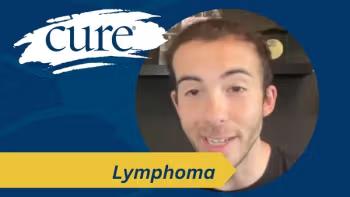
Exciting Developments in the Treatment of Multiple Myeloma
A researcher discusses the exciting times surrounding the development of novel agents designed to treat multiple myeloma.
Researchers are continuing to build on recent success in the field of multiple myeloma, says Dan T. Vogl, M.D.
For example, the CD38-targeted monoclonal antibody Darzalex (daratumumab), which was approved by the FDA in November 2015, is being investigated in earlier lines of therapy.
Additionally, efficacy is being showcased with other agents, such as KPT-330 (selinexor), Venclexta (venetoclax), and Viracept (nelfinavir). Viracept is an agent traditionally used for patients with HIV infections, yet it is showing impressive responses in combination with Velcade (bortezomib).
Chimeric antigen receptor (CAR) T-cell therapy is also making its way into the treatment landscape of multiple myeloma, with clinical trials ongoing and recruiting patients.
In an interview during the 2017 OncLive® State of the Science SummitTM on Hematologic Malignancies, Vogl, director of the Abramson Cancer Center Clinical Research Unit and assistant professor of medicine at the Hospital of the University of Pennsylvania in Philadelphia, discussed some of these novel agents alone and in combination. He also highlighted the potential with CAR T-cell therapy in the multiple myeloma paradigm.
OncLive: Please provide an overview of your presentation.Vogl: This is an exciting time to treat patients with multiple myeloma because, in addition to all of the great [therapies] that are already approved for treatment, there are some new options that allow us to keep treating patients for many lines of therapy—and we are getting good responses. One of our newer agents, Darzalex, is being increasingly used in earlier lines of therapy and can now be used in combination with Pomalyst (pomalidomide). I also discussed the upcoming introduction of subcutaneous formulation of Darzalex that will make the infusions a lot shorter for our patients, and make the treatment a lot more convenient.
There are a number of agents that are available right now for patients—but are not yet approved for multiple myeloma—that seem to have some efficacy. Specifically, the lymphoma medication Venclexta has clear efficacy, especially for patients with the 11;14 translocation. It also can work as a single agent, as well as in combination with Velcade. There are some early efficacy data—not necessarily just for patients with that abnormality.
There was also exciting data presented at the 2016 ASH Annual Meeting about nelfinavir, which is an anti-HIV medication, in combination with Velcade, that showed some impressive responses. Less exciting is Keytruda (pembrolizumab), which initially looked like it would have good efficacy for myeloma; however, based on some recently released data from randomized clinical trials, it may not be the best option for our patients.
On the other side, some of the other therapies that are in clinical trials now and may be introduced soon are very exciting. I discussed KPT-330, which is an inhibitor of a nuclear export protein that has clear efficacy in multiple myeloma as shown in a phase II trial; it demonstrated a response rate of 25%. However, the side effect profile can be somewhat challenging. There is an antibody-drug conjugate targeting the B-cell maturation antigen (BCMA), that has an impressive response rate of about 60% with a pretty good toxicity profile; although, there are some concerns about its ocular toxicity.
Some of the most exciting stuff coming out in myeloma has to do with CAR T-cell therapies. One of the trials that we did at the University of Pennsylvania using a CAR T cell targeted at BCMA had an impressive response rate in early phases and we are continuing to enroll patients. There are additional CAR T-cell studies that are coming up that will be opening soon, and we hope to see good responses there, as well.
Could you expand on nelfinavir and its potential in multiple myeloma?
Viracept is a fascinating story because the trial that showed efficacy was one that was not supported by any drug companies, but supported by academic funds. It was based on the idea that it should make proteasome inhibitor therapy work better. People have been trying to capitalize on the idea that if blocking the proteasome—which is a cellular organelle that degrades proteins—is good for killing myeloma, then we should be able to augment that response by looking at other ways of degrading proteins.
Viracept is an anti-HIV medication that is a protease inhibitor, so it also works by blocking the degradation of proteins. It’s not clear what protein it is targeting in human cells that are not infected with HIV virus, but it seems to really add something. Activity was seen in preclinical models, and it was demonstrated in a phase II trial where a group of patients who were refractory to proteasome inhibitors were treated with Velcade and Viracept; they are showing some very impressive responses.
If approved, how would a CAR T-cell therapy fit into the current treatment landscape?
We are still learning a lot about what CAR T-cell therapy is going to look like. On the one hand, we have seen some incredibly impressive responses that have lasted for a long time but, at the same time, too many of our patients have not responded in the initial trials. Or, they have a good response and relapse afterward. If we manage to make the therapy even better so that it [has curative potential], we will be using it a lot earlier on in therapy. It will be challenging if the toxicity profile remains somewhat difficult to navigate.
Where do the standard backbones of Revlimid (lenalidomide) and dexamethasone or Velcade and dexamethasone fall with these new agents?
Darzalex has been looked at in both combinations of these backbones. It has shown clear efficacy in both combinations, and is being used now as second- or third-line therapy routinely. The other new agents have only started to be examined in combinations. There is an ongoing phase III trial that just started combining KPT-330 with Velcade and dexamethasone compared with Velcade and dexamethasone alone. The other new agents are perhaps being used in combinations, but only in very early-phase trials.
Looking to the future of myeloma treatment, what steps should community oncologists start taking?
There are a lot of standard-of-care options right now. At the same time, it appears to be an incurable malignancy, and we know that all of our patients are eventually going to run out of those options. Looking ahead, as these patients are going through their final stages of the current standard-of-care therapy, think about referral to a tertiary care facility that is doing clinical trials. [These researchers] can think about some of these options and combinations that a community oncologist may not have thought of, and these can be very beneficial to patients.




